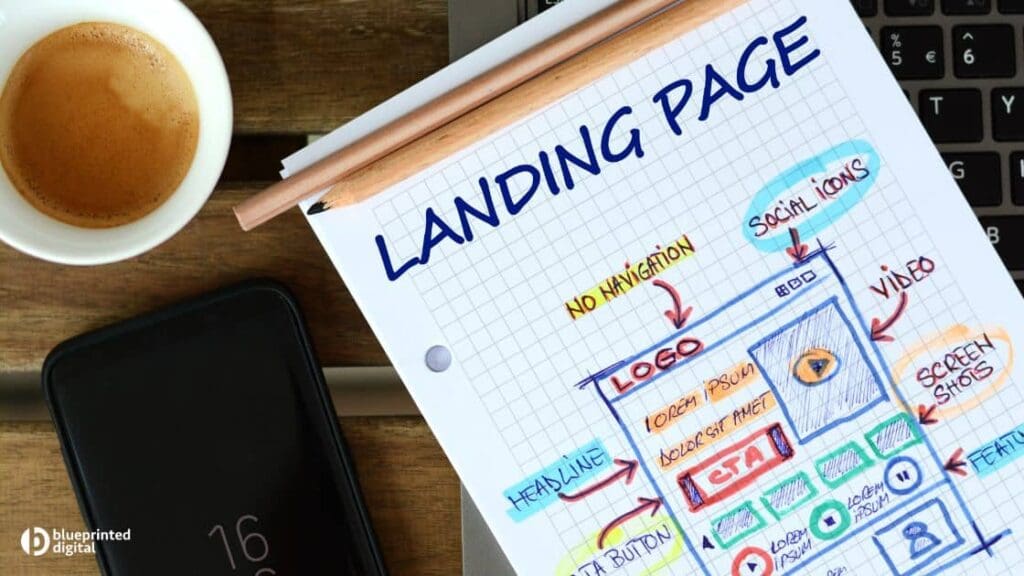What are Landing Pages?
To start, landing pages are a single web page, and they’re generally created as part of a digital marketing advertising campaign set up with a single purpose in mind – to sell a product or a service.
Let’s look at an example. Perhaps you’re a spa owner, and now that the holiday season is upon us, you’d like to ramp up your marketing efforts and try to sell more of a specific service, which you know is in high demand during this time of the year.
We all rack our brains trying to figure out the perfect gift to get that hard-to-shop-for person in our lives, and a spa package is just the ideal solution. So, as a business owner, you’ll first want to get your target audience’s attention – the husbands, the dads, and the boyfriends who’ll be purchasing this service.

Getting your business listed at the top of the Google search results page takes time – this is what we call organic positioning – and it’s achieved through long-term Search Engine Optimization (SEO) efforts.
However, since time is of the essence, given that we’re at the height of the buying season, you’ll want a quick and effective solution. So what do you do? The fastest and easiest way to reach your online audience is to set up a Google Ads and/or social advertising campaign (Facebook, Instagram, YouTube, etc.).
By using catchy copy and attractive visuals, your target audience will find your ad interesting and appealing, and naturally, they’ll want to click on it to learn more. What happens, then, is that this traffic will be sent to your landing page. When visitors arrive, they’ll see that this page is dedicated to your spa packages.
What Makes a Remarkable Landing Page?
A landing page will, first and foremost, be informative and to the point. It will NOT detail what the company does, its history, other services, or any other non-essential information. It’s set up for one goal, one purpose – to sell your specific service. Landing pages capture attention, engage visitors, and drive desired actions.
Several key elements contribute to making a landing page truly impressive:
- Clear and Compelling Messaging: A concise, compelling headline and subheading immediately communicates the value proposition or offer. Message clarity ensures visitors understand what they’ll get and why it’s valuable.
- Visually Appealing Design: A clean, visually appealing layout with attention-grabbing graphics, high-quality images or videos, and a design that guides the visitor’s eye toward the call-to-action (CTA).
- Strong Call-to-Action (CTA): A prominent, action-oriented CTA button or form that stands out and tells visitors what to do next. It should be strategically placed and use persuasive language.
- Relevance and Consistency: Alignment between the ad or link that brought visitors to the page and the content they find there. Consistency in messaging and design builds trust and reduces bounce rates.
- Mobile Responsiveness: Given the prevalence of mobile browsing, a remarkable landing page must be optimized for mobile devices, ensuring a seamless experience across all screen sizes.
- Compelling Copywriting: Persuasive, concise, and benefit-driven copy that highlights the unique selling points, addresses pain points, and convinces visitors to take action.
- Social Proof and Trust Signals: Incorporating testimonials, reviews, trust badges, or statistics can boost credibility and reassure visitors about the legitimacy and quality of the offer.
- Minimal Distractions: Eliminating unnecessary links, navigation menus, or clutter that could distract visitors from the primary goal, focusing solely on the desired action.
- A/B Testing and Optimization: Regularly test different elements (CTA, headlines, images) and optimize based on data and visitor behaviour to continuously improve performance.
- Loading Speed: A fast-loading page is crucial for retaining visitor interest. Slow loading times can lead to high bounce rates, impacting conversion rates.
A remarkable landing page combines these elements to capture attention and guide visitors seamlessly toward the intended action, whether it’s making a purchase, signing up for a service, or downloading content. Constant refinement and attention to user behaviour are essential for creating landing pages that truly stand out and drive meaningful results.
Are there Different Types of Landing Pages?
Yes, landing pages generally fall into two categories: 1. lead generation landing pages, which include a web form as the call-to-action, and 2. click-through landing pages, which have a button, such as ‘buy now’, and are typically used for e-commerce.
Some landing pages use video to quickly and effectively explain the product or service, while others use visuals, such as product images. Effective landing pages will also outline the benefits of using the product or service – usually with user/client testimonials.
The goal of a landing page is to convert that interested person into a buying customer. If you need help setting up your holiday campaign and creating a landing page for your offering, reach out!


